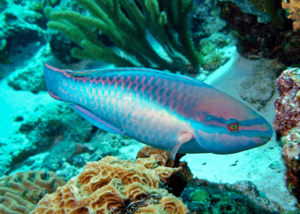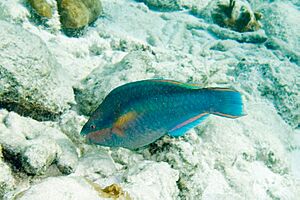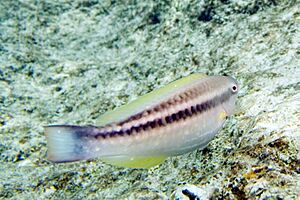Princess parrotfish facts for kids
Quick facts for kids Princess parrotfish |
|
|---|---|
 |
|
| Conservation status | |
| Scientific classification |
The princess parrotfish (Scarus taeniopterus) is a type of fish that lives in the ocean. It's part of a group called parrotfish. It usually grows to be about 20 to 25 centimeters (8 to 10 inches) long. You can find it in warm waters like the Caribbean, South Florida, the Bahamas, and Bermuda. Like other parrotfish, it swims around coral reefs and sandy areas during the day. It usually stays between 3 and 25 meters (10 to 80 feet) deep. It eats by scraping off algae.
Contents
Amazing Features of the Princess Parrotfish
Parrotfish are famous for their special jaws that look like a parrot's beak. Their teeth are all joined together. This helps them crush and grind their food. They even have a second set of teeth in their throat!
The color of a princess parrotfish depends on if it's a male or a female. Males often have a blue body with yellow areas. Females are white with shades of orange and brown. These fish have smooth, rounded scales called cycloid scales.
Where Princess Parrotfish Live and Their Role in Nature
Parrotfish are very important for the ocean's ecosystem. They help keep coral reefs healthy. They are also a food source for other animals. These fish scrape surfaces and dig into hard structures to find food.
They are known for eating algae. When there are too many parrotfish caught by fishing, algae can grow too much. This can harm the coral reefs. But when fishing is controlled, parrotfish help keep coral reefs clean. They do this by grazing on the algae.
You can find parrotfish in places like the Northern Great Barrier Reef, the Bahamas, and the Caribbean. They like to graze in shallow seas where coral grows well in sunlight. They prefer coral reefs but can also live among seagrasses. In areas with more predators, you might find more types of parrotfish.
Recent events like coral bleaching have changed where parrotfish live. Research shows that parrotfish numbers can increase after these events. This is because they create bare spots where new tiny living things can grow. It's important to keep watching coral reef habitats to protect them.
What Princess Parrotfish Eat
The princess parrotfish mainly eats algae. They also eat tiny coral polyps. They are mostly herbivores, meaning they eat plants. By eating algae, these fish help make space for young corals to settle and grow. They play a big part in helping coral reefs recover after big storms or other problems.
Their special beak-like jaws and fused teeth help them crush and grind their food. Climate change is starting to affect how much food is available for adult parrotfish. This is especially true in the Caribbean. Climate change can change ocean currents, which might lead to less food for them.
Reproduction and Life Cycle
Princess parrotfish lay eggs all year round. They usually do this when there isn't much sunlight. They lay the most eggs during the summer. The parents do not take care of their eggs or young.
Parrotfish eggs float away with the ocean currents. They usually hatch about a day after being fertilized. The young fish grow quickly. They can become adults in just a few years. Parrotfish can live up to 20 years. However, most of them live for 5 years or less.
Parrotfish have interesting ways of reproducing. Males can be born male. Or, they can be females that change into males. This happens based on what is best for them in their group.
Predators of the Princess Parrotfish
The main predators of parrotfish are humans and sharks. Humans catch them through fishing. Parrotfish protect themselves by hiding in caves within the coral reef.




